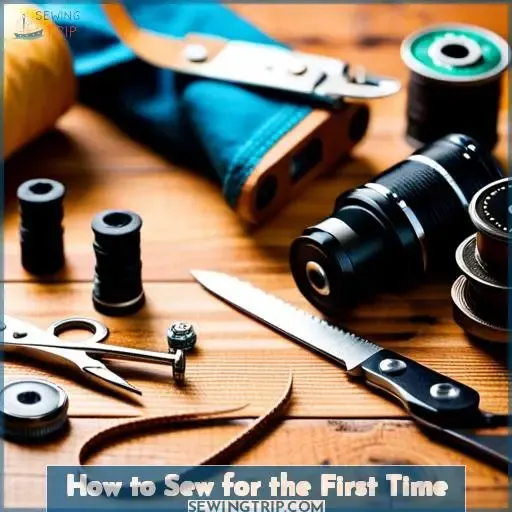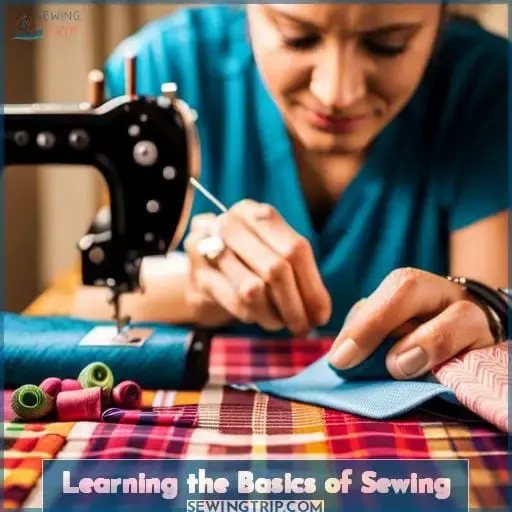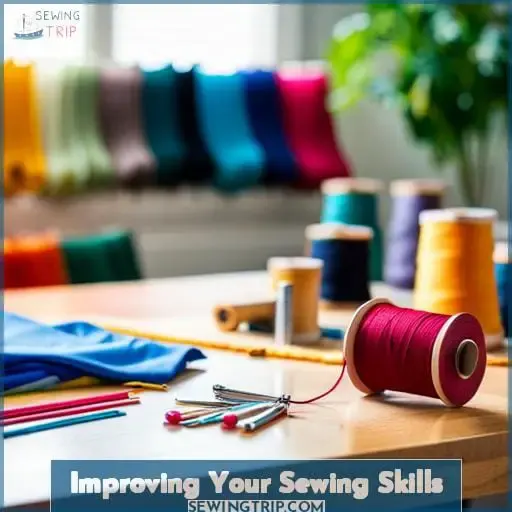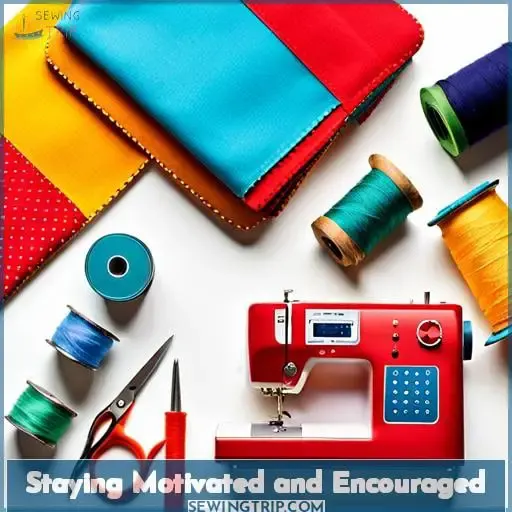This site is supported by our readers. We may earn a commission, at no cost to you, if you purchase through links.
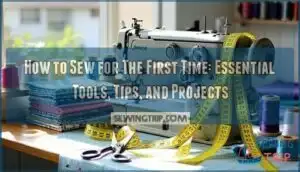
Table Of Contents
Key Takeaways
- Anyone can learn to sew with the right tools and knowledge, whether it’s through hand-sewing or machine-sewing.
- Essential sewing tools include scissors, thread, fabric tape measure, seam ripper, and needle wax, and fabrics should be chosen carefully depending on the type of garment or item being made.
- Beginner sewing patterns provide step-by-step instructions that cover basic sewing concepts such as seam allowances, hems, darts, and gathers, and free sewing lessons are available online for beginners.
- With practice and guidance, anyone can create beautiful pieces with ease, but it’s important to take your time, enjoy the process, and always remember the joy that sewing can bring.
Getting Started With Sewing
If you are just starting out with sewing, there are a few essential tools you will need. You can choose between hand-sewing and machine-sewing, depending on the project; each has its own unique uses and advantages.
Essential Sewing Tools
Once you have the basics, make sure to get yourself some essential sewing tools like scissors, thread, and a fabric tape measure. All of these will help you create beautiful pieces with ease! Start by investing in good quality sewing scissors.
For threads, consider different types such as cotton and polyester for various fabrics.
Secondly, look out for a reliable fabric tape measure that has both inches and centimeters marked on it. This is important when selecting the right size of cloth before starting any project.
Finally, choose fabrics carefully depending on what type of garment or item you are making. Lighter ones work well for soft furnishings, whereas heavier materials work best with bags or other items requiring more sturdiness.
Hand Sewing Vs. Machine Sewing
When it comes to crafting your perfect project, you have two options: hand sewing or machine sewing – both with their own unique advantages.
Hand stitching, often used for basting stitches and seam allowances, is a great choice for detailed projects like intricate hem options or topstitching seams.
Machine stitching offers the ability to quickly sew through multiple layers of fabric at one time, allowing you to finish your projects faster.
To help get started on either type of stitch technique, be sure to research fabric choices that work best with each method and find beginner’s guides online that offer tips on how to best use them in different types of projects.
Additionally, adding a little bit of washi tape can provide extra stability when creating hems as well as give added visual appeal – making it an ideal tool for beginners looking for more creative ways they can add personality into their pieces!
With the right knowledge base and some practice using these techniques, there’s no stopping what kind of beautiful creations you’ll make!
Choosing Your First Sewing Project
Are you new to sewing and looking for a place to start? Look no further! Beginner sewing patterns are the perfect way to learn. They will provide you with step-by-step instructions on how to create something amazing.
Beginner Sewing Patterns
Leverage your newfound sewing skills to explore the wide world of beginner-friendly patterns and create one-of-a-kind garments and accessories! Finding coordinating or mismatched fabric is an important part of any project.
You will also want to select thread colors that either contrast or blend with the fabrics used. Seam finishes are another essential aspect for ensuring projects last through wear and tear.
Mastering proper pinning techniques, pressing basics, and stitching together pieces of fabric smoothly is key when utilizing favorite free sewing patterns like a felt butterfly plush template or dishtowel kids’ apron pattern.
With practice comes perfection, so don’t be afraid to keep trying until you get it right.
Sewing Tips for Beginners
As you embark on your sewing journey, remember to take it one step at a time so that the process of transforming fabric into beautiful creations is an enjoyable experience.
A great place to start is by familiarizing yourself with the basics: fabric selection, thread selection, and hem techniques. Once you have these fundamentals down pat, move onto stitch types and needle threaders.
When learning how to sew straight lines for seams or hems, practice makes perfect! Make sure you also stock up on basic supplies like scissors and a tape measure. It’s important to learn some basic terms such as basting or pleat in order to make the most out of your first project.
Free sewing lessons are available online if needed – all designed for beginners just like yourself! Don’t be afraid – with patience comes success when tackling any new skill! So get creative today while honing in those key skills necessary for a successful outcome from any future projects ahead.
Learning the Basics of Sewing
If you’re new to sewing, it’s important to start by learning the basics – from how a sewing machine works and what supplies are needed, to terminology that will help you understand instructions. With patience and practice, you’ll soon discover just how rewarding this hobby can be! To get started on your journey into the wonderful world of sewing, let’s take some time to explore each of these key points in more detail: Sewing Machine Basics; Sewing Supplies; and Terminology.
Sewing Machine Basics
Take your sewing skills up a notch and learn the basics of using a sewing machine! There are many things to consider when getting started, from selecting the right model for you to understanding different fabric types.
Seam finishes, hem techniques, and small-scale engineering projects can be accomplished with just a few simple tools: scissors, thread, tape measure, pins or safety pins, and an iron. You should also have on hand a pin cushion for storing needles, as well as reference materials like pattern books or even online tutorial videos that provide easy directions about basic things such as bobbin winding.
An updated sewing dictionary is also helpful in knowing which stitch works best depending on what type of material you’re working with.
Sewing Supplies and Terminology
Gearing up for sewing? Get familiar with the essential supplies and terminology to get started – it’s a piece of cake! From thread, scissors, and tape measure to seam finishes, hems techniques, and an iron – you’ll be stitching like a pro in no time.
Here are some of the best things you’ll need before starting your first project:
- Fabric selection: Choose fabrics that match your pattern reading skills.
- Mastering stitches: Learn how to sew straight lines or curves on different kinds of material.
- Hemming techniques: Make sure everything is hemmed properly so it looks neat when finished.
- Seam finishing methods: Familiarize yourself with various types of finishes available such as French seams or zig-zag stitch edges.
- Little Thread & Cloth scraps: To practice how to sew for beginners, use small pieces of fabric along with little threads that would help develop hand-eye coordination while mastering basic sewing skills.
With these items in hand, you’re ready to take on any project confidently! So let’s begin our journey into learning How To Sew For The First Time!
Improving Your Sewing Skills
Congratulations on learning the basics of sewing! Now that you have mastered the fundamental skills, it’s time to take your sewing game up a notch. Improving your sewing skills can be both challenging and rewarding, but don’t worry – with patience and practice, you’ll soon be able to create amazing garments that fit perfectly.
One way to improve your sewing is by mastering easy hemming techniques. Hemming is an essential skill in garment construction as it gives a clean finish and makes clothes look professional.
| Fabric Type | Best Hem/Seam Finish |
|---|---|
| Lightweight cottons & linens | Rolled hem |
| Medium-weight wovens like denim & twill | Double-folded straight stitch |
| Knit fabrics | Mitered corner using zigzag stitch |
Apart from easy hemming techniques such as rolled hems or double-folded seams for medium-weight wovens like denim or twill, pattern cutting is also crucial when creating well-fitted clothing items, regardless of whether they’re skirts, dresses, tops, pants, etc.
It wouldn’t hurt to have a beginner’s guide supplies checklist handy, along with basic tools every sewer should have, including scissors, a fabric tape measure, and thread. Furthermore, easy-to-sew patterns will not only make comfortable learning more accessible but also provide good results without too much stress while still allowing room for creativity.
Improving your stitching requires consistency in practice, coupled with knowledge regarding which stitches work best for specific types of fabric. To sum up, then, the most important thing about improving one’s ability at this craft lies within understanding what works best according to individual needs.
Staying Motivated and Encouraged
Learning to sew can be very rewarding and beneficial. Not only will you have the satisfaction of creating something with your own hands, but it’s also an excellent way to express yourself creatively. If you’re just getting started, there are plenty of fun projects that won’t feel overwhelming or intimidating—so don’t be afraid! With a little time and effort invested in learning the basics, you’ll soon find out how enjoyable sewing can really be.
Benefits of Learning to Sew
You’ll love the satisfaction of creating your own clothes and accessories with sewing! Learning to sew offers many benefits that will make you feel proud and confident.
Making your own clothes saves money, and you can customize garments or accessories to fit any occasion. You also get a sense of accomplishment when overcoming challenges in pattern-making or when learning new techniques.
With fabric choices ranging from lightweight cottons for summer dresses to wool blend fabrics for winter coats, there’s something for everyone. You can even make special requests like soccer game shirts or baby burp cloths, all made with just thread and needle (or even better, a machine).
From simple repairs at home to full pattern-making skills down the road, learning how to sew is an incredible journey that won’t let you down.
Fun Sewing Projects to Try
Ready to get creative? Try your hand at some fun sewing projects that will show off your new skills! Start small with simple projects like a Jean Ball Dog Toy or Popsicle Sleeves. Move on to more complex ones such as Skillet Handle Covers, learning a variety of seam finishes and basic stitches along the way.
When it comes time for fabric selection, remember to always choose fabrics according to the pattern you are using so they won’t shrink when washed or fray too much after being cut out.
Have fun exploring free learn-to-sew tutorials online before jumping into larger sewing adventures.
Frequently Asked Questions (FAQs)
What type of fabric should I use for my first project?
You may be surprised to learn that the best fabric for your first project is not necessarily something expensive or exotic. Start with sturdy cotton, which will hold up well and allow you to experiment without feeling overwhelmed.
What type of sewing machine should I buy?
When it comes to choosing a sewing machine, there is no one-size-fits-all solution. You should consider the type of projects you plan on tackling and your budget. For starters, an ancient adage says, The devil is in the details.
Think about features like stitch length control or free-arm capabilities for more complex garments.
What types of stitches should I practice?
Start by practicing the basics: running stitch, backstitch, basting, and gathering stitches. Then, move on to decorative stitching, such as zigzags or blanket stitches. Get creative! With some practice, you can create beautiful projects and have fun along the way.
How can I find sewing patterns online?
To find sewing patterns online, search for a variety of projects. Look for free resources, tutorials, and guides that can help you get started.
What is the best way to store fabric and thread?
Store fabric in airtight containers and keep thread spools organized. Fold fabric neatly to avoid creasing, and ensure threads are wound securely on the spool.
Conclusion
Congratulations, you’ve made it! Sewing is a craft that can take years to master, but with practice and dedication, you’ll be able to create beautiful and useful garments and accessories. This journey has only just begun, and the possibilities of what you can create are endless.
With each stitch, you’ll find yourself growing more confident in your abilities and feeling proud of the items you’ve made.

